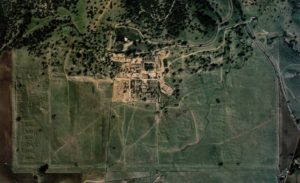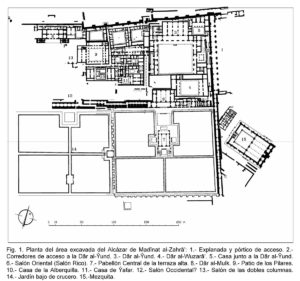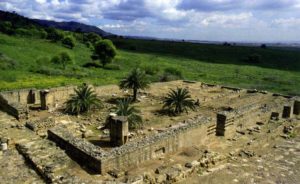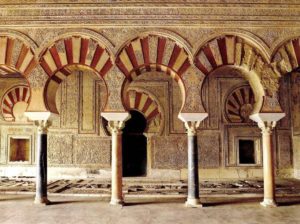
Madīnat al-Zahrā’

The palatine city of Madīnat al-Zahrā ‘was built between 936 and 940 by the caliph ‘Abd al-Raḥmān III as his official residence and the seat of the State administration. It was also constituted as a space of self-representation as well as a symbol of the Umayyad Caliphate and its significance and independence from the Eastern Caliphates. However, the medina barely survived a few decades since after the outbreak of the fitna, around the year 1009, the site was destroyed and looted.

The city adopted a rectangular shape and reached dimensions between the 1500 m in east-west direction and around 750 m from north to south. It was located a few kilometres from Cordoba on a rocky ledge at the foot of Sierra Morena mountains, a strategic enclave from which the Guadalquivir valley could be controlled and that allowed a hierarchical program of constructions in different terraces. The implementation of Madīnat al-Zahrā in the territory also provoked the creation of a series of roads and hydraulic infrastructures around it.

Although the excavated parts of the city only represent the 10 per cent of the urban space, it is well-known that the medina occupied a great lower plain, where non-built sectors existed. The only spaces constructed on this level were two broad strips, one to the west and another to the east; the Great Mosque were erected next to the last one.

The palace or Citadel (Alcazar) was located in the two upper terraces, in a prominent position over the rest of the medina. The palace had two distinct sectors: 1) a private zone, occupied by the residence of the caliph at the highest point (Dār al-Mulk), service areas and houses of figures related to the court like Ŷa’far; and 2) an official sector, with halls for receptions and other official acts, including the one known as the Reception Hall of ‘Abd al-Raḥmān III or the Oriental Hall.
Bibliography
ALMAGRO GORBEA, A. (2012): Planimetría de Madīnat al-Zahrā’, Granada.
BERMÚDEZ CANO, J. M. (1993): “La trama viaria propia de Madinat al-Zahra y su integración con la de Córdoba”. A.A.C., 4. Córdoba, pp. 259-291.
MONTILLA TORRES, I. y VALLEJO TRIANO, A. (2012): “Madinat al-Zahra. La Ciudad Brillante. La investigación como difusión”, Virtual Archaeology Review, 6, pp. 7-11.
PAVÓN, B. (1966): Memoria de la excavación de la mezquita de Madinat al-Zahra, Madrid.
VALLEJO TRIANO, A. (1990a): “Crónica años 1988-1990”, en Cuadernos de Madīna al-Zahra, 2, pp. 183-222.VALLEJO TRIANO, A. (1990b): “La vivienda de servicios y la llamada casa de Ya’far”, en BAZZANA, A. y BERMÚDEZ, J. (coords.): La casa hispano-musulmana: aportaciones de la arqueología, pp. 129-146.
VALLEJO TRIANO, A. (1991): “Crónica. Año 1991”, Cuadernos de Madīnat al-Zahrā’, 3, pp. 213-242.
VALLEJO TRIANO, A. (Coord.) (1991): El aprovechamiento del sistema de saneamiento en Madinat al-Zahra, Junta de Andalucía, Córdoba.
VALLEJO TRIANO, A. (1992): “Madīnat al-Zahrā’: el triunfo del estado islámico”, en Al-Andalus: las artes islámicas en España. Madrid, pp. 27-39.
VALLEJO TRIANO, A. (1994): “Problemas de gestión y administración de Madīnat al-Zahrā’ desde el inicio de su recuperación”, Arqueología y Territorio Medieval, 1, pp. 17-29.
VALLEJO TRIANO, A. (1995a): “El proyecto urbanístico del estado califal: Madīnat al-Zahrā’ “, en LÓPEZ GUZMÁN (coord.): La arquitectura del Islam occidental, Barcelona, pp. 69-81.
VALLEJO TRIANO, A. (1995b): “El salón de ‘Abd al-Rahmān III: problemática de una restauración”, en VALLEJO, A. (coord.): El salón de ‘Abd al-Rahmān III. Madīnat al-Zahrā’. Córdoba.
VALLEJO TRIANO, A. (Coord.) (2000): Madinat al-Zahra, 1985-2000. 15 años de recuperación, Junta de Andalucía, Córdoba.
VALLEJO TRIANO, A. (2001): “Madīnat al-Zahrā’, capital y sede del Califato omeya andalusí”, en VIGUERA, M. J.; CASTILLO, C. (coords.): El esplendor de los Omeyas cordobeses. La civilización musulmana de Europa Occidental. Granada, pp. 386-397.
VALLEJO TRIANO, A. (2002): “Conjunto Arqueológico de Madīnat al-Zahrā’: Un modelo singular de ciudad”, Mus-A, 0, pp. 106-111.
VALLEJO TRIANO, A. (2007a): “Madīnat al-Zahrā’: notas sobre la planificación y transformación”, Artigrama, 22, pp. 73-102.
VALLEJO TRIANO, A. (2007b): “Madinat al-Zahra’: transformation of a Caliphal city”, en ANDERSON, G.; ROSSER-OWEN, M. (eds.): Revisiting al-Andalus: perspectives on the material culture of Islamic Iberia and beyond. Leyden-Boston, pp. 3-26.
VALLEJO TRIANO, A. (2009): Madīnat al-Zahrā’. Guía oficial del conjunto arqueológico. Sevilla.
VALLEJO TRIANO, A. (2010): La ciudad califal de Madīnat al-Zahrā’. Arqueología de su arquitectura. Córdoba.
VALLEJO, A. y ESCUDERO, J. (1999a): “Crónica del Conjunto. Años 1992-97”, Cuadernos de Madīnat al-Zahrā’, 4, pp. 235-296.
VALLEJO, A. y ESCUDERO, J. (1999b): “Crónica del Conjunto. Años 1998-2003”, Cuadernos de Madīnat al-Zahrā’, 5, pp. 473-527.
VALLEJO, A. y FERNÁNDEZ, R. (2010): “Una aproximación a las canteras de piedra calcarenita de Madīnat al-Zahrā’”, Cuadernos de Madīnat al-Zahrā’, 7, pp. 405-420.
VALLEJO, A.; MONTEJO, A.; GARCÍA CORTÉS, A. (2004): “Resultados preliminares de la intervención arqueológica en la “Casa de Yafar” y en el edificio de “Patio de los Pilares” de Madīnat al-Zahrā”, Cuadernos de Madīnat al-Zahrā’, 5, pp. 199-239.

